It’s always a pleasure to address this group. Like you said, it’s like family. It’s like being here well, I think it’s been at least probably 15 years I’ve been going to Naval Submarine League events. And then as Jay said, probably the last almost 10 years as either a PM or a PEO or the PMD a lot of “P” words there I’ve been blessed to be able to address this group. You’ll see why when my talk is through.
My talk is supposed to really cover broader than just the submarine force, and you’ll see as I weave in some of those that go with our excellence in the submarine force. I’m going to give you a view of the broader Department of Navy acquisition achievements and how we’re changing to this rapidly changing environment that Daryl talked about. And also, my view of industry’s part.
We have a new secretary, Secretary Spencer, our 76th Secretary of the Navy, and he recently published his priorities: people, capabilities and processes, which is the underpinnings of making our Navy team stronger.
And I really should say our naval team, Navy and Marine Corps team, stronger, more responsive and more lethal. He calls us to renew our sense of urgency and speed of execution throughout the entire organization, and we are doing just that.
I am ever impressed with the scope of our Navy and Marine Corps teams, acquisition, modernization, sustainment work, from the Joint Strike Fighter to the Amphibious Combat Vehicles, the Flight 3 DDGs to Virginia class SSNs, over $60 billion of procurement and research and development every year.
Secretary Stackley, he has departed the building after nine years of being RDA and, for a period, acting secretary of the Navy for the last seven months. A true national asset. It’s hard to over-state the impact that Secretary Stackley has had on our Navy and Marine Corps teams’ success.
Fortunately for us, good people attract a good team. Secretary Stack ley left behind a strong team that is able to keep our Navy and Marine Corps’ acquisition and research and development on course. So, I just want to give you a few examples of what has been done just since January of ’17.
We’ve had a lot of christenings, nine christenings, deliveries, commissionings, major contract awards, and even other significant events like milestones. You’ll see this in the delivery we had two this year for our Virginia class submarines. We got the mighty Washington and the Colorado delivered. I was fortunate enough to just participate in the South Dakota’s christening with D.B. Dempsey as the sponsor. What a fabulous event.
But you can see that the work of the Navy progresses on and it’s across the spectrum, from DDGs to LCSs to carriers to Joint High Speed Vessels to Virginia-class submarines. Even the work in our missile and weapons business, you can see a Standard Missile 6 test right there.
But even more in the air business, you look at the content for unmanned, this thing called Triton, a fabulous capability. It sent full motion
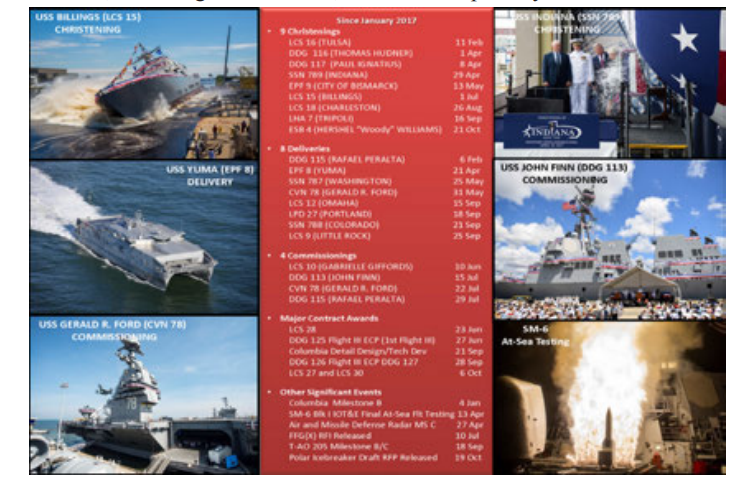
video over a common data link to the Ike that’s what that says and completed its joint integrated test on Link 16. So that thing can see and it can communicate, and I think it will bring a really game changing capability to our force.
We also are in the weapons business. You see AARGM, we know that as AIM-120D, which is the premier missile used by our Naval air forces. We also do helicopters. The Marines are recapitalizing their heavy lift capacity, which is CH-53K King Stallion. What an unbelievable aircraft that is.
I was fortunate enough to go to Sikorsky and talk to them there, and you know what? Sikorsky designs reduction gears. Actually, if you look at the top of a 53K, it looks a lot like a submarine reduction gear. It is taller than I am, that’s how heavy that gear is when you’re lifting something that’s got near 100,000 pounds between the aircraft and what you’re pulling underneath it. It’s just an incredible aircraft.
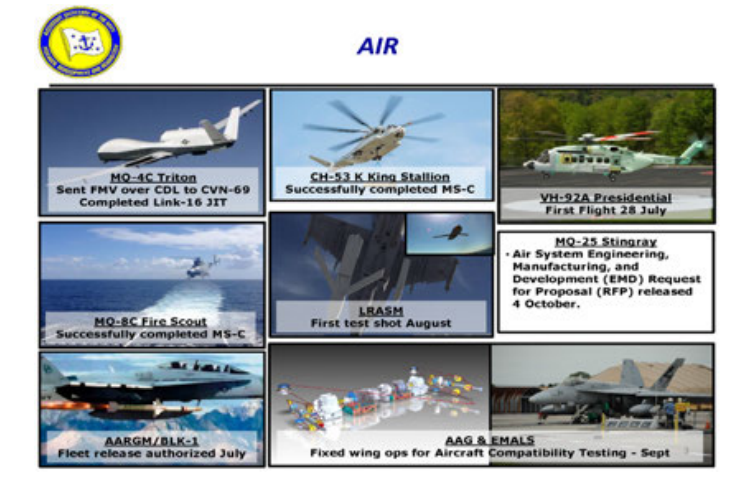
We also do things like the presidential aircraft or presidential helo, which is also done at Sikorsky in Oswego. We just had the chance, Secretary Spencer and myself, we went up to there and visited with Ms. Houston and her team at Oswego. What a great event. Six o’clock on Friday evening all those folks were there because they wanted to be there and listen to the Secretary and actually celebrate the work that they do there. It just makes you feel good about the work we do every day in the Department of Defense.
The MQ-25 Stingray I-well, I’ll talk about that a little bit later. Also, we have this thing called the Advanced Arresting Gear and the EMALS, our aircraft launch system. Those are actually being exercised as we speak, because the Ford is underway, (catting and trapping) using those systems.
Even beyond that with my Marine Corps team brothers, the Joint Light Tactical Vehicles with the Army. We’re upgrading the Amphbious Assault Vehicle, think of that, all the way back to the Vietnam era, a new transmission, survivability upgrades. The Marines are about to get almost like a SPY 1D on the ground. It’s the GATOR, Ground, Air, Task Oriented Radar. It’s a gallium arsenide right now, later to gallium nitride
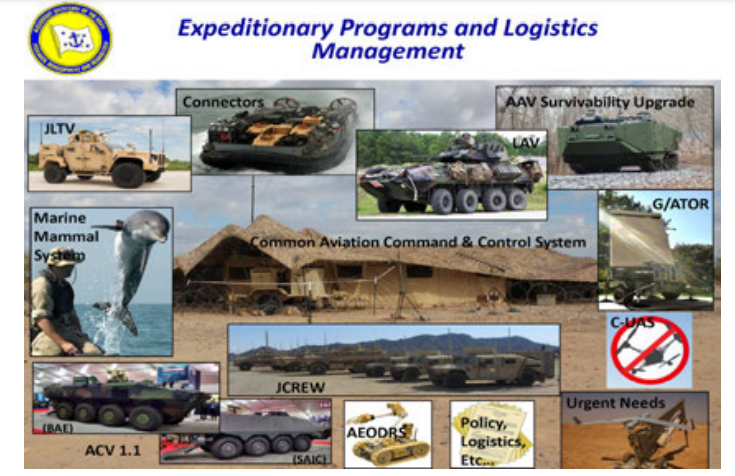
radar, a fabulous capability. If you link that with the Common Aviation Command and Control System, they will be able to do some work from the shore for the Navy and Marine Corps team.
Also, very much into the unmanned business, you see the RQ-21 Blackjack there in the lower right corner, which is deployed currently today with a Marine Expeditionary Unit. So, we’re moving fast, and of course the Marines large acquisition is the Amphibious Combat Vehicle. ACV 1.1 is the initial tranche, two vendors, and they’re out testing. As a matter of fact, Jimmy Smith, who is my DASN E&LM is out there looking at that today.
R&D, the press does not stop on the work of developing our folks. If you look at the lower right on there, additive manufacturing is obviously a big deal. We had a very interesting event in the Pentagon where we set up a 3D printathon. Folks went around and could see actually how we’re making a difference in the field, from small stuff to big stuff. This is definitely a growth area and it actually can be very much of a game changer and enabler to help improve our availability of assets in the field because you can just make them right there at the point of use.
Also, we had a fabulous ship to shore maneuver experiment, we called it as part of ANTX, it was a very unique event out at Camp Pendleton and we brought the Commandant of the Marine Corps out there. I’m somewhere in that crowd of folks. It really gave us a way to see how unmanned can change the calculus of bringing ashore capability, establishing networks and bringing the fight without putting the Marine at risk. And then using those unmanned assets to directly actually go with the manned asset to go after the threat. It was really a very unique experiment.
That progresses in GATOR, and so there is a way to actually take away the experiment and move it into something that goes to the next step and eventually ends up as an enabling capability in the fleet’s hands. It was very, very well done. That’s a pretty good quick sweep through. Now, unfortunately, I have to go back to the Pentagon.
So back at the Pentagon, it’s the budget. When I became PMD, Secretary Stackley said, Dave, it’s budget, budget, and nothing but the bud- get, and he was right. We are in the middle of still finishing the fiscal year ’18 budget. We have been engaging with the authorizers and the PSMs even as late as this week working as they get their bills finalized, as well as with the appropriators.
Next year’s budget, Program Objective Memorandum ’19, POM, it’s with our secretary of defense friends and it is actively being worked with the services. POM ’20, it’s happening, because the CNO’s guidance for 2020 strategically guides what we program for and deliver for capability.
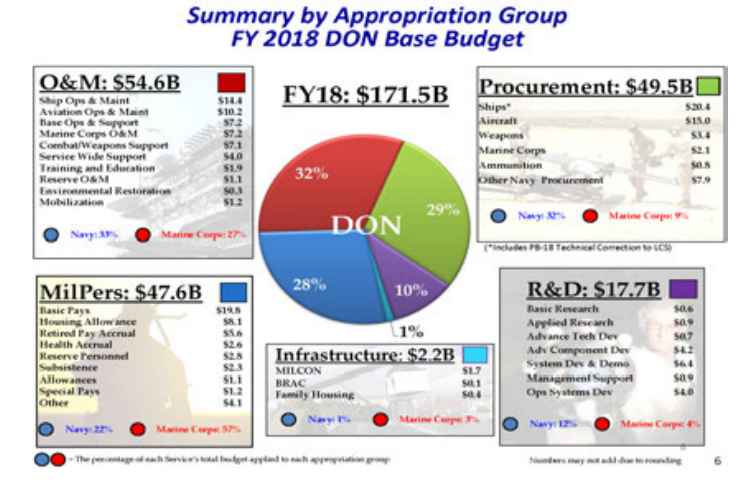
That is actually a draft and we should be finalizing that here in the next few weeks. So, it’s moving.
We are entering a period of historic growth and stability for platforms, weapons and warfare systems. Aircraft, the Joint Strike Fighter, with the procurement of 445 aircraft across a three year block buy, that’s lots, 12-14, that includes the United States, Navy and Marine Corps and Air Force, and partner nations aircraft. In the long run the U.S. will steady up on something over 90-plus aircraft a year between the U.S. Air Force and the Naval forces.
F-18 E/F Super Hornets, I think we’re going to keep building them and we’ll build them potentially even up at rates as high as 24 per year all the way through potentially the FYDP. E-2D, Advanced Hawkeyes, you want to talk a game changing aircraft in our fight for the future, the E-2D is it and we’ll build those at four to six per year.
Ships, as this audience knows, we’re getting Virginia-class submarines. The plan of record will meet two a year all the way through Columbia. There’s even some discussion of potentially plugging in three a year at certain key points, all in the pre decisional phase. SSBNs we’ll be at one a year. We’ll be cranking them out from FY ’26 on for those Columbia class SSBNs.
DDGs, two to three a year, so basically something like a one-two, one-two, or two-three, two-three. It’s just math. If you want to have 66 submarines you build them at two a year with a 33 year life. It’s the same thing for the large surface combatants, and that’s the way we’re looking ahead.
CVNs, we’re currently today on five year centers, and we’re even looking at going to three and a half year centers as a possible acceleration to reduce costs and move us more towards the goal of 12 CVNs. And then LCSs and frigates, getting us to two to three ships per year.
But that’s not all. Missiles are also in this mix. The Standard Missile at 125 per year, again, a game changing missile capability. I’ll just rattle off a few of the other things that we are doing: maritime strike Tomahawk; LRASM, which I’ll cover later; AARGM, which I showed a picture of; the AIM-120D; HARPOON block II-plus;, the Evolved Sea Sparrow Missile, and more at optimal rates.
This department and this secretary of Defense and the deputy are very interested in us working at or above minimum sustaining rates for our weapons. And, of course, torpedoes, with the Mark 48 restart, its upgrades, and the Mark 54 Mod 1 profile ramping as we field those advanced capabilities. So, in this context, we have to build a framework for the CNOs push for what he calls exponential growth and capability. And we have to deliver this more powerful fleet not later, but in the 2020s.
So how do we get at this? I see five elements. We have to get digital. We have to modernize. We have to start right with industry and foreign requirements, and we have to rapidly innovate, and yes, we have to reform.
I’ll go through each of those, and I’ll start with get digital. The Digital Warfare Office has been stood up under Ms. Margie Palmieri , and I have a deputy for her, Captain Select Anderson. He’s an Engineering Duty Officer in OPNAV N2N6 under Vice Admiral Jan Tighe.
The DWO brings together efforts across the warfare sponsors and drives the Navy’s efforts to effectively use and fuse our existing data, the push for Big Data analytics, and predictive analysis, and leads cross-PEO digital warfare pilots. Two of my PEOs are intimately involved, PEO unmanned weapons and PEO integrated warfare systems, to net
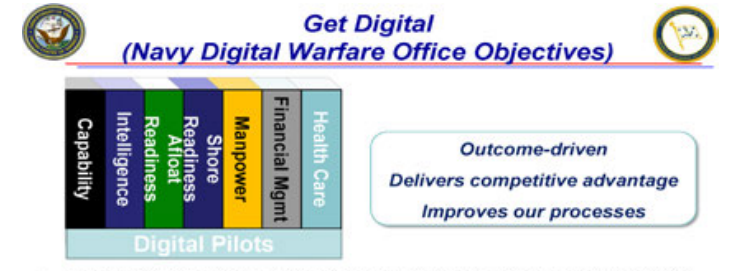
and use the power of our Navy’s data in new ways that exponentially increase our combat effectiveness. I’m only touching the surface here. This is truly revolutionary work and is where our CNO is driving our Navy.
Modernize. The CNO states in the Future Navy paper, that we must design in the ability to modernize: plug and play hardware matched with the software and reprogrammability to make upgrades quicker and more affordable even as we stay more capable. This is the submarine modernization model and it is being followed by the surface ship and even the Joint Strike Fighter programs. I call them receptors, designing and building the open architecture platforms with combat weapon and sensing system upgradability.
I’m talking about more than just combat system and electronic systems upgradeability. It’s hull, mechanical and electrical modularity that enables affordable and timely upgrades. Virginia Block 3, the first of which Vice Admiral Tofalo referred to in his remarks, the North Dakota, has Virginia Payload tubes, and 87 inch diameter common interface pulled through from the SSGNs and enabling Tomahawk, multiple all-up-round canister use, UUV payload transfer system and future payload insertion affordably and quickly because the supporting infrastructure
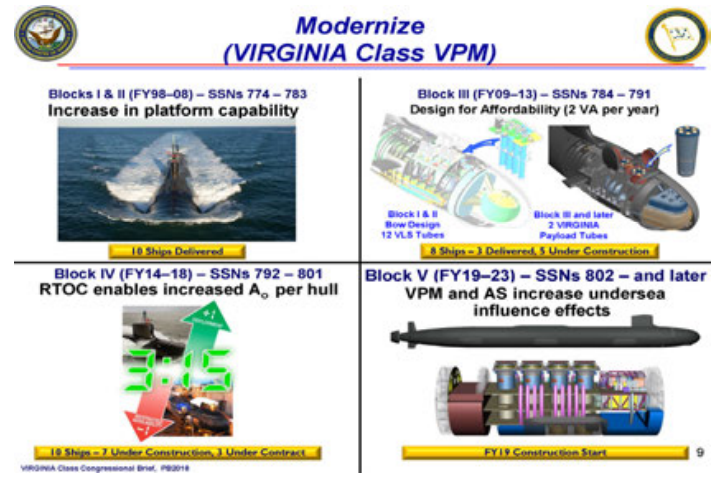
was built in with margin for growth and change. This submarine industry has led the way and must continue to do so.
The next step, the Virginia Payload Module in Block V is only possible because during Virginia’s design in the 1990s the team envisioned hull plugs to advance the ships capability, an idea thought up over 25 years ago. That is now coming to reality in the 2019 to 2023 Block V multi year contract. Even closer is South Dakota, an FY ’13 authorized ship which the Navy is using as a technology demonstrator to prove out advanced technologies.
Lessons learned from South Dakota will be incorporated into Block V and later Virginia-class submarines. The right design with a knowledgeable Navy-industry team to evolve the design to respond to a continuously changing threat, that is what keeps our naval capability moving at relevant speed. Modernizing our existing platforms is the fastest way to field advanced capability at capacity and move our naval capability up.
Three, industry and foreign requirements. The Navy’s future frigate, it is a model along with the MQ-25A which I’ll discuss later for how the Navy works with industry to inform its requirements and get them right from the start.
The frigate team worked within the Navy, between the fleet, the Pentagon and the acquirers, the PEOs and the PMs that fully develop the trade space for what the Navy needed to fight in the distributed maritime operations environment; the concept of operations, the Navy’s current systems and planned upgrades and cost and schedules.
We then, only after that, went out to the industry with a very well thought out request for information in July to get industry’s view on achievability, the breadth of potential solutions globally, possible trades and potential costs.
The result was an industry informed and fully vetted CNO approved requirement on the 3rd of October. That will go forward for the concept designs in the next phase this fall. With speed and precision, the Navy and Industry were able to do the hard work up front to speed the acquisition and drive toward a platform that the Navy needs, all on a schedule for late FY 2020 award.
MQ-25A, the Maritime Accelerated Capability Office is in full form and continues to evolve. The stingray, carrier-based tanker released its request for proposal a month ago and will be down-selected and on con-tract by the end of this fiscal year, with an IOC of 2024. For our new
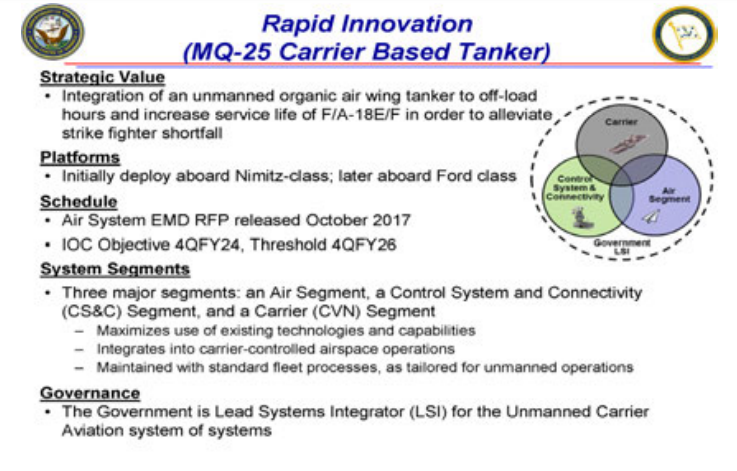
carrier-based aircraft, this is fast. But expectation is that once an industry partner is selected we’ll be able to go even faster.
The MQ-25A is a model for Navy technical leadership as the system integrator and for industry input into the requirements, and into the acquisition approach, between a draft RP, several one-on-one sessions with the four competitors, funded concept refinement studies to develop the trade space and an industry informed requirement much like FFG(X). I’ve never seen it done better than what Rear Admiral Mark Darrah and his PEO U&W team (unmanned aviation and strike weapons) accomplished. More groundbreaking work, but that is not all
Under Captain John Rucker the UUV family of systems, with the snakehead large displacement UUV, ORCA-XL UUVs, they’re moving ahead with streamlined decision chains, knowledge point acquisition and focus teams to keep the press on rapid fielding. Also included are the surface naval laser weapon family of systems and the expeditionary SURTASS capability from an expeditionary EPF. Something fast, it’s a joint high speed vessel, if you can remember that.
MACO and RPED, they will continue to be evolved, and believe me, it has the personal attention of both the Chief of Naval Operations and the Acting RDA. This rapid acquisition I’m discussing has even a better near term example, the Long Range Anti ship Cruise Missile. This pro- gram under Captain Todd Huber, was awarded Aviation Week’s laureate for defense programs and is a model program for accelerated acquisition, developing a technically challenging weapon on an accelerated timeline affordably and meeting the warfighter needs.
In only two and a half years from the requirement CDD, LRASM is in integrated tests with ITE-1 taking place last August. That is a dropping out of the B-1 bomber you see there, with an early operational capability on the Air Force’s B-1 next year, and the F-18 E/F in 2019. Simply superb performance that is happening today and it’s proof that the Navy-industry team can move at relevant speed when this team puts its will and its resources to the task.
One might ask, why or how did Todd and his team do this? What’s their model? It’s simply the model that all our rapid acquisitions are following.
A lead, in this case it was called the LRASM Deployment Office, but a lead set up specifically within the program for LRASM. The use of knowledge points, program milestones, close interaction with industry, a tight team of developers, users and testers, a high reliance on high-end


modeling and simulation, to retire the risk based on results. Targeted in-air tests, monthly sessions with MDA. Yesterday we just held another executive steering board on LRASM, and not just me but with all the stakeholders, to assess and steer the program progress and quickly resolve issues, be they technical, financial or contractual, all with short decision chains.
The ability to engage the right level of leadership quickly to get obstacles removed and problems solved is a key element to this rapid business. Many of these same processes are being used in the MQ-25A, UUVs, and more broadly across the acquisition enterprise. Streamlining the process is critical. Even more critical is having the right team doing the work.
A government-industry team of knowledgeable, empowered, experienced professionals can make the right decisions at the right time. I’ve referenced before the U.S. Air Force’s study on owning the technical baseline as a model for principles applicable to getting acquisition of even high-risk capability done rapidly. I recommend you spend the time and give it a read.
Taking even a step further back from where we’ve come, rapid innovation. Implicit in our team’s ability to deliver capabilities to keep at that capacity side of the equation, driving excellence in execution, building CVNs, the SSNs and DDGs that form the backbone of our Navy’s fleet, rapid acquisition has scale. What’s fast for a missile or a UUV is different from what’s fast for a major ship platform.
We should strive to minimize design and build timelines looking for what’s inhibiting faster delivery to the fleet. The effort to drive Virginia-class from 84 to 60 months, cutting two years off the build time, this audience did just that.
You moved the needle and sped ship deliveries through engineering, manufacturing and contracting, ships with ever improving capability and quality. That same focus is what’s required to meet this historic growth in submarine workload with a sustained two per year Virginia and one per year Columbia, a doubling of the workload across the enterprise.
Adding to the scale is technology and change: added Virginia Payload Modules, acoustic superiority, restart of the missile compartment industrial base, and the first modern electric drive submarine. Keeping the industrial base on plan is the number one priority for the submarine

force. Issues here will overwhelm our teams and detriment progress else where. The Virginia Columbia integrated enterprise plan is the single most important effort that this team here today has to face in this next decade.
And finally, I have to talk about this “R” word, reform, a major thrust within the Department of Defense. Reform of our processes and approaches so that we within the Navy do absolutely everything we can to drive down cost. For acquisition, it means using the tools we’re all well familiar with for better buying power and ship costs, driving multi- year procurements and block buys, pricing at market rates, improving contracting, including shortening the timelines, procuring at more economic rates, and building stability into our profiles, all common-sense approaches to acquisition.
This line of reform thinking, relooking at how we do business, assessing our approaches with all its internal biases, assumptions and inertia, it all fits the construct that in the end we really do have to be pre- pared to fight and win today and tomorrow. That is why there’s the press today for rapid acquisition that’s agile, modern and sustained, to get at the Navy we need as fast as theoretically possible. We must, in the words
of DOD guidance, quote, “Move at the speed of relevancy and adapt to today’s challenges and prepare for tomorrow’s threats,” unquote. But there’s more. In my prior talks, I’ve noted the tremendous achievements from our acquisition system and covered the competitive environment we’re seeing every day from China, Russia, Iran, North Korea and violent extremist organizations. These competitors are trans- forming themselves before our eyes. I refer back to a CNO quote I’ve used before on competition.
One, going back to this idea of competition, “all of our leaders have got to be waking up every morning and spending their day thinking about how they can beat the competition. We have got to get competitive,” un- quote. I see two ingredients here in this business that we’re in here every day, process and culture.
Starting with process, that’s a SECNAV top three priority and it’s Congress’ call to reorganize DOD acquisition and R&D for our nation’s competitive advantage to achieve the overarching objectives of technical superiority and weapons system affordability. The 2017 NDAA, Section 901, called for the reorganization of the undersecretary of defense for AT&L. It has to be done by 1 February next year into two entities.
I will not discuss the chief management office, but really focus on the under secretary of defense for research and engineering to drive innovation and accelerate advancement of our warfighting capability, and the undersecretary of defense for acquisition and sustainment to deliver proven technology into the hands of the warfighter more quickly and affordably.
This new organization refocuses the office of the secretary of defense’s principal role from program oversight to that of direction of major department investments to ensure integrated, technically superior capability that consistently outpaces the threat. The “901 report” is publicly available and it’s worth the read. Nurturing and maturing the right technologies for success handoff to the acquisition side, that is critical to our success.
Congress has provided the department with the impetus to significantly streamline the acquisition organization and assign greater responsibility, accountability and authority to where the expertise lies in the services for program execution and performance. This is critically important. This is a critically important change to the OSD oversight vector of the past, to a supporting role vector for the future.
Congress’ intent, it’s about our own ability to beat the competition, and it goes far beyond reorganizations and just process. It really is about culture, an environment where always looking for a better way is expected and held accountable for. For those of you who listened to me talk in September, this is the same example I used.
I recently finished listening to the biography of Elon Musk, the founder of Tesla, Space-X and Solar City, a true innovator. His success was not by brilliance alone, it was more about how he approached the problem, setting what seemed like unachievable goals and achieving them. In 2004 Space-X needed an actuator that would trigger the gimbal axle to steer the upper stage of the Falcon 1 rocket. Musk was quoted $120,000 for the actuator.
Musk thought that was ridiculous, thinking it no more complex than a garage door opener. He put his engineer to the task of designing one that cost no more than $5,000. Nine months later his engineer did just that, delivering an actuator that accomplished the task for $3,900, about 1/30th the original quote. Getting there extracted every ounce of innovation, knowledge and perseverance out of that engineer.
While it’s a great story, it has application here. You see, Elon Musk was technically savvy about his rockets and knew what was theoretically achievable when he gave the engineer that task. Now, I know the same is true of our undersea enterprise. We submariners, we pride ourselves on our technical knowledge of the details and our understanding of the business.
Like Elon Musk, we should use our innate knowledge to set our standards and goals at levels we would have thought impossible. I can tell you no one in 2005 thought we would take two years out of the Virginia build and 20 percent out of the cost, while redesigning with a new bow and improving capability, but we did. We can do the same as Elon Musk did for Space-X and Tesla, applying our rigor, our knowledge and our drive and expertise to move faster responsibly and affordably.
So, in closing, I’ve only given you a high-level look at what I see as ways which we together can get at rapidly developing capability and capacity to the fleet affordably. It is stable acquisition profiles for open architected platforms that lays the foundation for rapid capability insertion via well thought out modernization approaches, such as SWFTS and payload tubes for submarines, and continuous development of game changing seed corn technologies and approaches that bring capability with the right balance of technological risk, cost and supportability to the fleet, all on relevant timelines.
We are at an inflection point. Our competitors are outpacing us and are delivering capability designed to defeat us at our game. We have to change the calculus.
Even in the undersea domain we should not feel comfortable. N97’s capital submarine enterprise plan, the TCEP, it is a call to move ahead to drive innovation and to move. This is not mission impossible. I am convinced we have the intellectual capital within this very room to take on this national challenge.
We must keep at it, and by it, I mean a series of action verbs: exe- cute; invest; innovate; communicate; think long term; deliver; improve; drive costs, a relentless pursuit, not the tyranny of the learning curve; own; lead; expect, no, demand that we accomplish what we once thought was impossible; all basic stuff. That is the mindset that we need and is a difference between winning and losing. We must approach this as a national endeavor and win this competition. I am convinced it is within our own power to do so.
Thank you.

